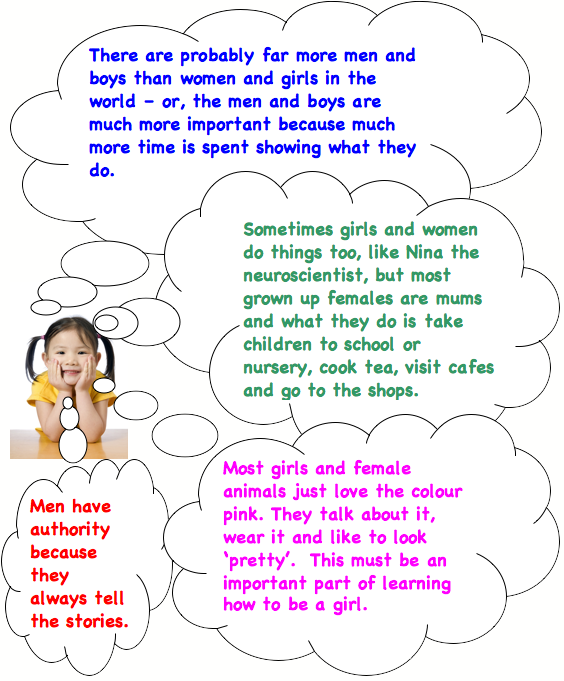Under-representation of females in pre-school children's television
OR
Mummy, why don't girls and women get to do much stuff? Is it because they aren't important?
Helen Mott, November 2008
Subject and method
On a single weekday (22nd October 2008) I watched as much output from the BBC CBeebies channel as I could.
In total I watched 365 minutes (6 hours 5 minutes) of CBeebies. With repeats this is equal to 625 minutes in total, or 10 hours 25 minutes from the total programming of 775 minutes (12 hours 55 minutes). I recorded details about who presented programmes, who narrated stories, who were the main characters in programmes and who were the peripheral characters. These observations are based upon an objective assessment of the programme content.
The issue:
 you
are three years old, learning about the world and how it works. You are just beginning to find out that
people and animals have genders: about half the world is male and about half
the world is female. You don't go
to school yet, although you might go to nursery. You probably spend a significant amount of time (if you are
anything like my three-year old!) finding out about the wider world outside
your own family circle from CBeebies.
you
are three years old, learning about the world and how it works. You are just beginning to find out that
people and animals have genders: about half the world is male and about half
the world is female. You don't go
to school yet, although you might go to nursery. You probably spend a significant amount of time (if you are
anything like my three-year old!) finding out about the wider world outside
your own family circle from CBeebies.
 What if your earliest ideas about gender
are informed by programming that shows men and boys 'taking the lead',
presenting information, telling stories, doing exciting things and being at the
centre of attention? What if girls
and women are under-represented, fixated on the colour pink and present at the
periphery of the action? What if
even most of the puppets, animals and other creatures who populate the world of
children's television strangely defy gender balance by 'happening' to be
male?
What if your earliest ideas about gender
are informed by programming that shows men and boys 'taking the lead',
presenting information, telling stories, doing exciting things and being at the
centre of attention? What if girls
and women are under-represented, fixated on the colour pink and present at the
periphery of the action? What if
even most of the puppets, animals and other creatures who populate the world of
children's television strangely defy gender balance by 'happening' to be
male?
Is CBeebies consistently giving boys and girls their first crucial lessons about their place in the world and setting out the "rules" for conforming to restrictive gender roles and stereotypes?
Background: The CBeebies service licence issued in April 2008 describes its remit and its contribution to the promotion of the BBC's public purposes.
'The remit of CBeebies is to offer high quality, mostly UK-produced programmes to educate and entertain the BBC's youngest audience. The service should provide a range of programming designed to encourage learning through play in a consistently safe environment for children under 6 years old."
"Reflecting the UK's nations, regions and communities: CBeebies should make an important contribution to this purpose amongst its audience by offering content from many different parts of the UK and by stimulating, supporting and reflecting the diversity of cultural activity in the UK. CBeebies should reflect a wide mix of children and presenters in terms of disability, gender and ethnicity."
1. Presenters and Anchors
I looked at the people featuring as the main anchors or presenters in the programmes.
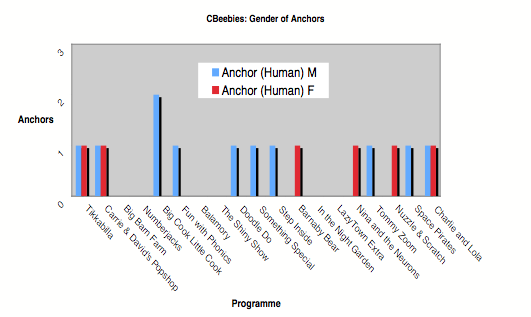
So – men or boys headed up programmes 11 times while women or girls were the main anchors in 6 programmes.
HIGHLIGHTS
Nina and the Neurons: Nina the Neuroscientist has her own fun educational show.
Carrie and David's Popshop: Carrie and David working very much as an equal team creating pop songs for children. Carrie rocks! And she isn't wearing her hair in pigtails.
LOWLIGHTS
Step Inside: "Mr Mopple" presents the show, and interacts with Boris the bookcase, provider of stories. And the story is about a boy who saves the day. There is a female present: it's Twinkle the cat who sports the obligatory pink neckbow.
2. Presenters and anchors – animals, puppets, and other non-humans
CBeebies features many characters who aren't human adults or children. They include animals, puppets and aliens. But almost all of them are gendered too.
I looked at the main anchors of programmes in this category.
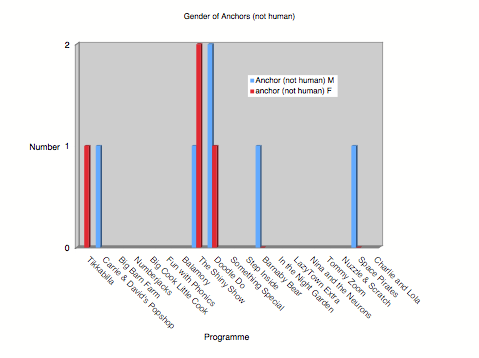
So, even among the non-human "stars of the show" there were 6 male characters and 4 females.
3. Narrators of stories
Several of the programmes in the day's viewing contained stories that were narrated by a character (such as Derek Jacobi who voices over In the Night Garden).
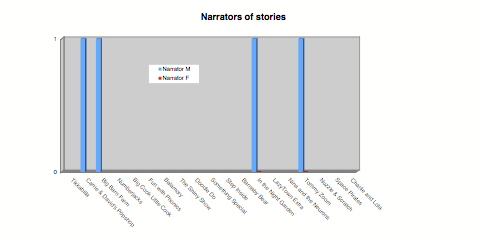
There were no female narrators of stories in the day's viewing. There were 4 male narrators.
4. Main characters
Here we come to the crunch. Each programme follows a narrative – and I recorded who the 'main actors', or the protagonists, were in each case.

Male characters took the lead in the action on 30 occasions during the day's viewing. Females were central on just 13 occasions. In other words, 70% of the action was being undertaken by males.
HIGHLIGHTS
Numberjacks: Well this is hardly brilliant, but in today's adventure, numbers 5 and 3 (both female!!) go to sort out the havoc being wrought in the world by the Spooky Spoon (also female).
LOWLIGHTS
Space Pirates. Children are asked to vote on three pieces of "music to dress up to". The first is a Kinks song performed by the on-ship band Windy, Stringy and Brassy (two male puppets and a female – she is "Brassy"). Second up is a video of Nelly Furtado singing the pop song "Powerless" (!) and finally we see a group of men performing a Chinese Lion Dance.
Tommy Zoom: This series is all about the adventures of Tommy, his brother Sam, his dog Daniel, and the baddies Polluto and Smog (they're boys too).
Barnaby Bear: Barnaby and his father go camping together on the River Thames, stopping to find out interesting facts from a river warden and a lock keeper who are also men. There is a female teacher in the background and two of the children in her pond-dipping group are girls, but they are peripheral to the action and don't talk to the camera.
5. Supporting characters
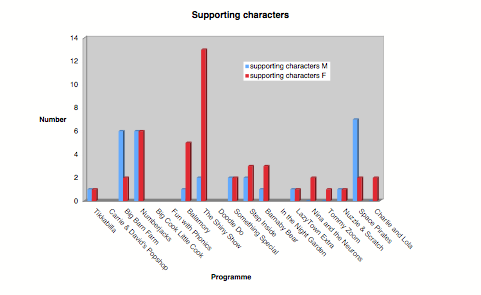
In contrast to each of the previous categories, female characters make an appearance – in fact outnumber male characters by 44 to 30 – when it comes to supporting, or peripheral roles. Passing references are made to 'mum' figures who are there in the background, making tea or collecting characters from nursery.
HIGHLIGHTS
Nina and the Neurons: Rebecca is the main character, who wants to know why her tummy rumbles. Our experimenters who go to find out the scientific answers are a girl, Jennifer, and her mother.
Numberjacks: It was heartening to see that the 'agents' – children reporting details of number-related mayhem – were all played by girls who were also all of minority ethnic or mixed heritage.
LOWLIGHTS
Space Pirates: the secondary storyline involved all the characters of this strange programme: the Captain of the ship, Captain DJ and his faithful dog sidekick Jingles; Jolly Rogers the animated flag; Zorst the alien newsreader; the puppets Windy & Stringy and the boy Tonk. The only female characters are the girl, Honk, and Brassy, the musical puppet. It is the boy character, Tonk, whose actions drive the story.
Numberjacks: While the 'special agents' were all girls in this story, the real agents (that is, the people filmed having experiences in the real world) were:
a boy with a heavy rucksack;
a man going bowling;
2 men playing table tennis;
a man changing a wheel on a car;
a man cleaning a floor;
a woman in a cafe trying to eat a pizza; and
a girl playing with a balloon in a park.
Big Barn Farm: In a story all about Gobo the (male) goat, who loves to eat, we encounter Gobo's friends on the farm. They are Mac the horse, Digger the dog, 'the farmer', Lester the rooster and Dash the donkey (all male) and one female animal – Petal the pig.
The Shiny Show: The theme for the episode is Dancing. At last, a preponderance of females on the screen – but who are they and what are they doing? They are dancers doing ballet of course. We watched the people referred to as "Pretty ladies dancing" and I asked my son, "Would you like to be a ballet dancer?". He replied, "No, I can't get those skirts on. Or boobs." Then we watched Irish dancing (all female dancers again) and finally some children learning ballet, at which point we were asked to notice that there were two boys in among all the girls in the class.
How CBeebies educated toddlers about gender on 22nd October 2008
OR
Conclusions that a three year old would be entitled to draw
